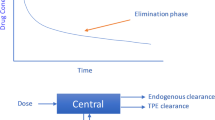Abstract
Successful heparin-free hemodialysis has been reported in adults but not in children. A preliminary study was carried out to determine whether heparin-free hemodialysis was possible in children who were considered to have a high risk of bleeding, and if so, to identify the children in whom this technique might be expected to succeed. Of 28 heparin-free procedures, 21 (75%) were successful, a major clot developed in 4, and a minor clot occurred in 3. These children were 6.76±4.57 years old and weighed 20.7±11.3 kg. An activated clotting time (ACT) of less than 170 s was recorded in five of the six patients in whom clotting was observed (normal value 146 s with a range of 110–180 s). In a second prospective study, low-dose heparin was prescribed for patients with an ACT of less than 170 s, while the remaining children again underwent heparin-free dialysis. In this study only those patients with double-lumen vascular access and a predialysis systolic blood pressure greater than 80 mmHg were included. Their mean age was 12.25±4.61 years and their weights 32.9±19.3 Kg. In 28 of 31 (90%) procedures, no clotting was observed. Minor clotting developed during the remaining 3 procedures, all in one child who weighed 8.5 kg (the only child weighing less than 10 kg). Heparin (9.6±3.2 IU/kg body weight per hour) was administered during 18 successful procedures. This study shows that heparin-free hemodialysis is possible in children, particularly, but not exclusively, those with a coagulopathy. Clotting may be anticipated in children weighing less than 10 kg and in those in whom the ACT falls below 170 s. Heparin (10 IU/kg per hour) is recommended for these patients.
Similar content being viewed by others
References
1.Glaser P, Guesde R, Rouby JJ, Eurin B (1979) Haemodialysis without heparin is possible. Lancet II: 579–580
Caruana RJ, Raja RM, Bush JV, Kramer MS, Goldstein SJ (1987) Heparin free dialysis: comparative data and results in high risk patients. Kidney Int 31: 1351–1355
Schwab SJ, Onorato JJ, Sharar LR, Denis PA (1987) Hemodialysis without anticoagulation. One-year prospective trial in hospitalized patients at risk for bleeding. Am J Med 83: 405–410
Casati S, Moia M, Graziani G, Cantaluppi A, Citterio A, Mannucci PM, Ponticelli C (1984) Hemodialysis without anticoagulants: efficacy and hemostatic aspects. Clin Nephrol 21: 102–105
Sanders PW, Curtis JJ (1986) Management of anticoagulation for hemodialysis. In: Nissenson AR, Fine RN (eds) Dialysis therapy. Mosby, St. Louis, pp 39–41
Nevins TE, Mauer SM (1986) Infant hemodialysis. In: Nissenson AR, Fine RN (eds) Dialysis therapy, Mosby, St. Louis, pp 237–240
Donckerwolcke RA, Chantler C (1987) Dialysis therapy—hemodialysis. In: Holliday M (ed) Pediatric nephrology, 2nd edn. Williams and Wilkins, Baltimore, pp 799–804
Pinnick RV, Wiegmann TB, Diederich DA (1983) Regional citrate anticoagulation for hemodialysis in the patient at high risk for bleeding. N Engl J Med 308: 258–261
Zusman RM, Rubin RH, Cato AE, Cocchetto DM, Crow JW, Tolkoff-Rubin N (1981) hemodialysis using prostacyclin instead of heparin as the sole antithrombotic agent. N Engl J Med 304: 934–939
Kelleher SP, Schulman G (1987) Severe metabolic alkalosis complicating regional citrate hemodialysis. Am J Kidney Dis 9: 235–236
Swartz RD, Prot FK (1979) Preventing hemorrhage in high-risk hemodialysis: regional versus low-dose heparin. Kidney Int 16: 513–518
Hampers CL, Blaufox ND, Merrill JP (1966) Anticoagulation rebound after hemodialysis. N Engl J Med 275: 776–778
Schrader J, Stibbe W, Armstrong VW, Kandt M, Muche R, Köstering H, Seidel D, Scheler F (1988) Comparison of low molecular weight heparin to standard heparin in hemodialysis/hemofiltration. Kidney Int 33: 890–896
Hemker HC (1989) A standard for low molecular weight heparin? Haemostasis 19: 1–4
Fareed J, Walenga JM, Hoppensteadt D, Racanelli A, Coyne E (1989) Chemical and biological heterogeneity in low molecular weight heparins: implications for clinical use and standardization. Semin Thromb Hemost 15: 440–463
Schmitt GW, Moake JL, Rudy CK, Vicks SL, Hamburger RJ (1987) Alterations in hemostatic parameters during hemodialysis with dialyzers of different membrane composition and flow design. Platelet activation and factor VIII-related von Willebrand factor during hemodialysis. Am J Med 83: 411–418
Author information
Authors and Affiliations
Rights and permissions
About this article
Cite this article
Geary, D.F., Gajaria, M., Fryer-Keene, S. et al. Low-dose and heparin-free hemodialysis in children. Pediatr Nephrol 5, 220–224 (1991). https://doi.org/10.1007/BF01095957
Received:
Revised:
Accepted:
Issue Date:
DOI: https://doi.org/10.1007/BF01095957



